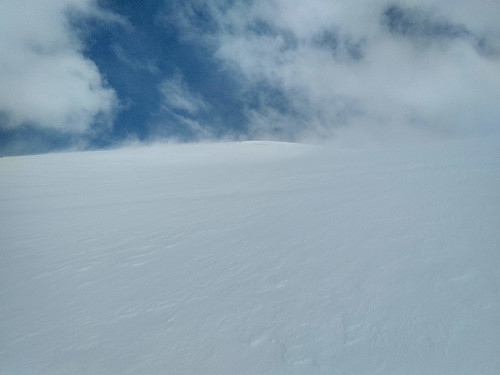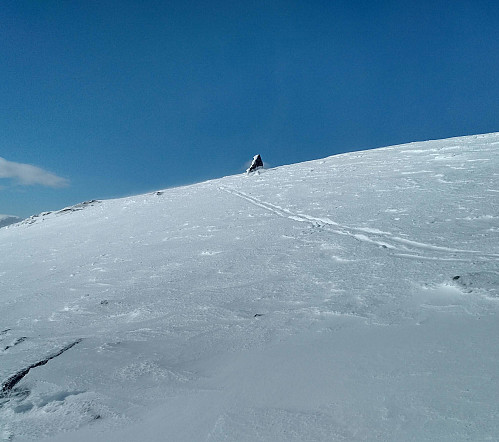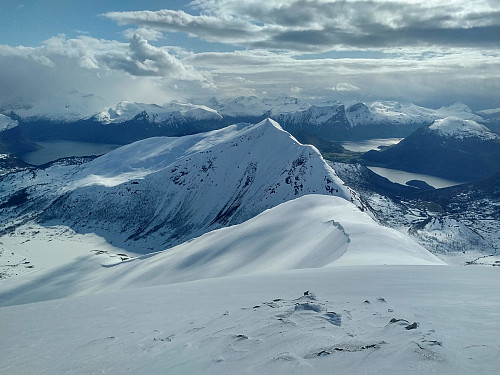Alpine Ski Touring to Mount Smørbottind and Mount Kvasstind (09.05.2020)

| Start point | Skorgedalen Parkering (316m) |
|---|---|
| Endpoint | Skorgedalen Parkering (316m) |
| Duration | 3h 46min |
| Distance | 12.0km |
| Vertical meters | 2,272m |
| GPS |
|
| Ascents | Kvasstinden (1,188m) | 09.05.2020 12:44 |
|---|---|---|
| Smørbottinden (1,189m) | 09.05.2020 12:44 | |
| Visits of other PBEs | Parkering Skorgedalen (305m) | 09.05.2020 12:44 |
![##1-12: I just got myself a set of alpine touring ski equipment, and this was in fact my first mountain trip ever with alpine touring skis; i.e.; I've previously always been using my Telemark skis for such trips. #1: My brand new K2 alpine touring ski boots purchased online from Conrad Sport in Germany. #2: My new Dynafit bindings, also purchased from Conrad. #3: A set of brand new Contour skins purchased online from Kårvatn Mountain Equipment [Norw.: Kårvatn Fjellutstyr] in Norway. #4: My old Völkl Mantra skis with Cobra Telemark bindings from Rottefella, the way I bought them at G-Sport, Ålesund, Norway, more than 10 years ago. (I know, real off piste ski enthusiasts would say it's sacrilegious to mount Telemark bindings onto a pair of Mantra skis, and I kind of agree, but this is what they sold me back then when I asked for a pair of "Telemark skis"...). Nevertheless, I later bought a pair of proper Telemark skis from Scottybob in Colorado, and since then my Mantra skis haven't been in use until now. #5: Attaching the new Dynafit bindings onto my old Völkl skis. #6: The new bindings in place. The epoxy glue used in the drill holes prior to entering the attachment screws is seen in the background. #7: The new boots in place in the bindings. The colour combination might seem a bit weird with red skis, blue bindings, and olive green boots; I'll probably have to get myself an orange or yellow pair of shell trousers, maybe along with a purple shell jacket, to match up with these colours. #8: The boots fitting nicely into the front bindings. #9: Rear binding in touring mode. #10: The rear bindings in "climbing mode", the right one as you would use it in rather steep climbs, and the left one the way it is used in not so steep climbs. #11: Rear binding in downhill mode. #12: Adapting the Contour skins to fit the skis.](https://images1.peakbook.org/images/14939/Solan_20200510_5eb7e68aefb6f.jpg?p=large)
Whenever I’ve been mountain skiing throughout the last few years (i.e. on trips shared here on PeakBook), I’ve always been using my Scottybob Telemark skis. I have been dreaming of buying a nice pair of alpine touring skis as well, however, but due to the cost connected with such a procurement, I’ve not done it until now. I’ve been having a nice pair of off piste skis that have been stored in our garage, and which I haven’t been using for a numbers of years. I actually bought them as a pair of Telemark skis back in 2007 or 2008, and I used them quite a lot for the first few years, but I stopped using them after I got my Telemark-specific Scottybob skis. For a number of years now, I’ve been thinking of mounting some alpine bindings onto my old off piste skis, as the Völkl Mantra is well known as a steady off piste ski; but then my son asked me: Why don’t you rather put a pair of touring bindings onto them? I had to admit that was indeed a very good idea, and so I ordered a set of Dynafit bindings, along with a pair of K2 touring boots online from Conrad Sport in Germany; and then I ordered a pair of skins for the skis with Kårvatn Fjellutstyr [lit.: Kårvatn Mountain Equipment].

I removed the old Cobra Telemark bindings from the Mantra skis, and mounted my new Dynafit bindings about a week ago (Images ##1-12); and now I was so eager to try out the skis, that I went to Rauma Municipality, where there's still plenty of snow, even though the weather forecast wasn't that good. I went to Skorgedalen Parking lot, where I put on my new touring equipment, and started ascending Mount Smørbottinden. I actually did climb mount Smørbottind even 5 weeks earlier, but then with Telemark skis; hence now that I had this alpine touring equipment, I was even interested in comparing the time used from the parking lot up to the summit on these two occations. The touring skis felt a bit lighter than my Telemark skis. When climbing the mountain with Telemark skis on April 4th, however, there were some nice ski tracks that I could follow, whereas today the snow was sludgy in the lower parts; and higher up in the mountain side, where the snow was dryer, there was a lot of wind, that had removed whatever tracks there might have been after other skiers.


As I started out, weather was quite cloudy, and it was snowing intermittently. As I was approaching the summit, however, weather improved, with a nice blue sky in between the clouds, and even some sunshine every now and then. I reached the summit of Mount Smørbottind after about 2 hours and 7 minutes, which was a slight improvement compared to what I had been able to accomplish with Telemark skis 5 weeks earlier (i.e. 2 hours and 12 minutes). I had expected the difference to be greater, as the Mantras were feeling much lighter than the Scottybobs; but as mentioned, I was following very nice ski tracks when I did this climb with my Scottybobs, and the snow was also much nicer on that occasion. Moreover, I might have pressured myself a bit harder on that day in the beginning of April, because I still remember I felt a bit exhausted when I reached the summit back then; whereas this time I didn't feel quite so exhausted.


Feeling that I had still some energy and strength in my body, I even felt up to continuing onto Mount Kvasstind on this occasion. So I went down to the notch between the two mountain tops without removing the skins from my skis; as you only have to descend about 120 elevation meters from Mount Smørbottind to get down there; and then I started climbing Mount Kvasstind. Both Smørbottind and Kvasstind have some huge snow shelves at this time of the year, and they sometimes brake off, sending anyone standing on them into the abyss. As I was climbing Mount Kvasstind, therefore, I made sure I was climbing in safe distance to the edge with the snow shelves (see image #....). On top of Mount Kvasstind I removed the skins from my skis, then put on my helmet and my ski goggles; and had a chocolate bare and a soda drink, before embarking on downhill skiing back down to my car and the parking lot.




User comments